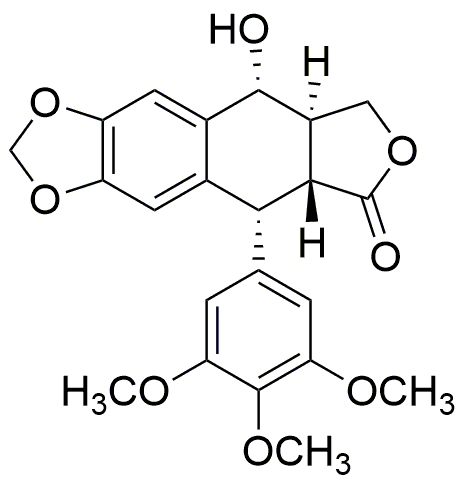Podophyllotoxin is widely utilized in research focused on:
- Anticancer Treatments: This compound is a key ingredient in the development of chemotherapeutic agents, particularly for treating testicular cancer and certain types of leukemia. Its ability to inhibit cell division makes it effective in targeting rapidly dividing cancer cells.
- Antiviral Applications: Podophyllotoxin has shown promise in treating viral infections, particularly human papillomavirus (HPV). It is used in topical treatments for warts caused by HPV, providing a non-invasive option for patients.
- Pharmaceutical Research: Researchers are exploring its potential as a lead compound for synthesizing new derivatives with enhanced efficacy and reduced toxicity. This opens doors for innovative drug development in oncology and virology.
- Natural Product Chemistry: As a naturally occurring compound, it serves as a model for studying plant-derived substances. This research can lead to the discovery of new therapeutic agents and contribute to the field of herbal medicine.
- Biochemical Studies: Podophyllotoxin is used in laboratory settings to study its mechanisms of action on cellular processes. Understanding these mechanisms can help in designing better-targeted therapies for various diseases.
Información general
Propiedades
Seguridad y normativas
Aplicaciones
Podophyllotoxin is widely utilized in research focused on:
- Anticancer Treatments: This compound is a key ingredient in the development of chemotherapeutic agents, particularly for treating testicular cancer and certain types of leukemia. Its ability to inhibit cell division makes it effective in targeting rapidly dividing cancer cells.
- Antiviral Applications: Podophyllotoxin has shown promise in treating viral infections, particularly human papillomavirus (HPV). It is used in topical treatments for warts caused by HPV, providing a non-invasive option for patients.
- Pharmaceutical Research: Researchers are exploring its potential as a lead compound for synthesizing new derivatives with enhanced efficacy and reduced toxicity. This opens doors for innovative drug development in oncology and virology.
- Natural Product Chemistry: As a naturally occurring compound, it serves as a model for studying plant-derived substances. This research can lead to the discovery of new therapeutic agents and contribute to the field of herbal medicine.
- Biochemical Studies: Podophyllotoxin is used in laboratory settings to study its mechanisms of action on cellular processes. Understanding these mechanisms can help in designing better-targeted therapies for various diseases.
Documentos
Hojas de datos de seguridad (HDS)
La SDS proporciona información de seguridad completa sobre la manipulación, el almacenamiento y la eliminación del producto.
Especificación del producto (PS)
La PS proporciona un desglose completo de las propiedades del producto, incluida la composición química, el estado físico, la pureza y los requisitos de almacenamiento. También detalla los rangos de calidad aceptables y las aplicaciones previstas del producto.
Certificados de análisis (COA)
Busque certificados de análisis (COA) ingresando el número de lote del producto. Los números de lote y de partida se pueden encontrar en la etiqueta de un producto después de las palabras "Lote" o "Lote".
Número de catálogo
Número de lote/lote
Certificados de origen (COO)
Este certificado de origen confirma el país en el que se fabricó el producto y también detalla los materiales y componentes utilizados en él y si se deriva de fuentes naturales, sintéticas u otras fuentes específicas. Este certificado puede ser necesario para cumplir con las normativas aduaneras, comerciales y regulatorias.
Número de catálogo
Número de lote/lote
Hojas de datos de seguridad (HDS)
La SDS proporciona información de seguridad completa sobre la manipulación, el almacenamiento y la eliminación del producto.
DownloadEspecificación del producto (PS)
La PS proporciona un desglose completo de las propiedades del producto, incluida la composición química, el estado físico, la pureza y los requisitos de almacenamiento. También detalla los rangos de calidad aceptables y las aplicaciones previstas del producto.
DownloadCertificados de análisis (COA)
Busque certificados de análisis (COA) ingresando el número de lote del producto. Los números de lote y de partida se pueden encontrar en la etiqueta de un producto después de las palabras "Lote" o "Lote".
Número de catálogo
Número de lote/lote
Certificados de origen (COO)
Este certificado de origen confirma el país en el que se fabricó el producto y también detalla los materiales y componentes utilizados en él y si se deriva de fuentes naturales, sintéticas u otras fuentes específicas. Este certificado puede ser necesario para cumplir con las normativas aduaneras, comerciales y regulatorias.


